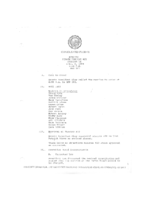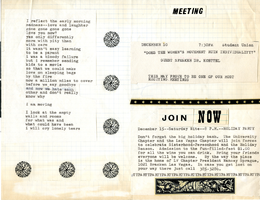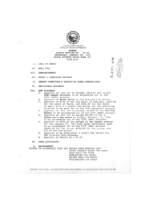Search the Special Collections and Archives Portal
Search Results

Meeting minutes for Consolidated Student Senate University of Nevada, Las Vegas, December 6, 1984
Date
Archival Collection
Description
Text

Meeting minutes for Consolidated Student Senate University of Nevada, Las Vegas, April 4, 1984
Date
Archival Collection
Description
Text

Antioco Carrillo interview, 2019: transcript
Date
Archival Collection
Description
Interviewed by Monserrath Hernández, Rodrigo Vazquez, and Laurents Benitez-Bañuelos. A native of Jalisco, Mexico, moved to Las Vegas when he was about 20-year old in 1987. Attended CSN and UNLV. His history with Las Vegas is embedded in the 1980s Las Vegas gay scene and education for AIDS. He is and activist and the Executive Director of Aid for AIDS of Nevada. He and Theodore Small are the first same-sex marriage in Nevada.
Text

National Organization for Women artwork and ephemera, 1970s
Date
Archival Collection
Description
Zine, artwork, and magazine for the National Organization for Women (NOW).
Text
Klai, John, II, 1952-2023
John Reynolds Klai II was born and raised in Osnabrock, North Dakota. After spending a few years as an accounting major at the University of North Dakota’s College of Business in Grand Forks, an engineering class inspired him to pursue a career in architecture. He returned to Osnabrock, where he worked for his father’s construction company and saved to attend the architecture program at North Dakota State University (NDSU) in Fargo. He received a Bachelor of Arts in Architectural Studies in 1977 and graduated with a Bachelor of Architecture in 1978.
Person
Fun One Bowling League Records
Identifier
Abstract
The Fun One Bowling League Records (1987-1997) contain league schedules, membership documents, standing sheets, and other organizational records from the Fun One bowling league, an LGBTQ bowling league that was established in Las Vegas, Nevada in 1985. Fun One was the Las Vegas LGTBQ community's second bowling league.
Archival Collection
Dennis McBride Collection of Gay Erotica
Identifier
Abstract
The Dennis McBride Collection of Gay Erotica (1960-2006) contains a selection of pornographic publications, three VHS tapes of erotic films, and photographic prints mail ordered from gay erotica or physique photography studios. The three studios represented in this collection are Alexander Studio, Sierra Domino Studio, and Third World Studio.
Archival Collection
D. L. Washburn Photograph Collection on Sasha's Nightclub and Restaurant
Identifier
Abstract
The D. L. Washburn Photograph Collection on Sasha's Nightclub and Restaurant is comprised of primarily candid photographs of patrons and entertainers such as musicians, female impersonators, and male strippers at Sasha's Nightclub in Las Vegas, Nevada from approximately 2001 to 2003. The collection includes photographs of Sasha Scarlett with patrons and entertainers at the nightclub. The majority of individuals in this collection are unidentified.
Archival Collection

Meeting minutes for Consolidated Student Senate University of Nevada, Las Vegas, January 20, 1993
Date
Archival Collection
Description
Text
Lee Plotkin Papers
Identifier
Abstract
The Lee Plotkin papers document Plotkin's political work and associations as an LGBT activist and spokesman for the Las Vegas gay community, and include correspondence, press releases, copies of his columns, institutional and legislative documents, brochures, fliers and other ephemera from 1955 to 2006.
Archival Collection
